You’ve got an old smartphone collecting dust in a drawer, and you’re paying monthly fees for a home security system that doesn’t quite cover every angle you need. What if that forgotten device could become your next line of defense? Your outdated phone already contains the camera, processor, and connectivity features that make expensive security cameras work. The transformation requires just a few strategic steps, but there’s one critical factor that determines whether your setup will actually protect your home or leave you vulnerable.
Why Repurpose Old Smartphones for Home Security
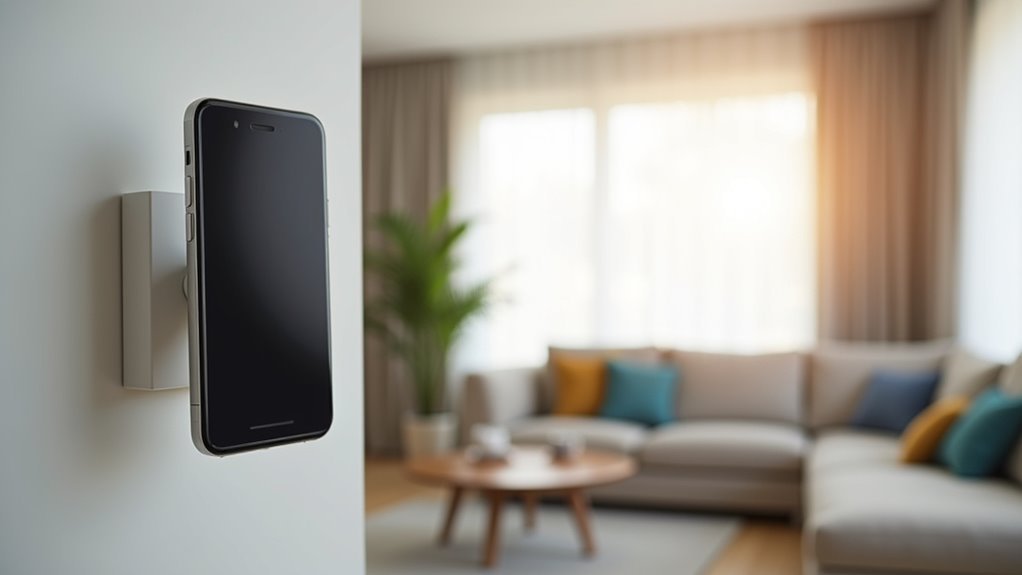
While traditional security systems can cost hundreds or thousands of dollars, you can transform your old smartphone into an effective security camera for virtually no cost. Instead of letting old phones collect dust in drawers, you can repurpose them using security camera apps like Alfred to create an effective home monitoring system.
This approach offers multiple benefits beyond savings. You’ll reduce electronic waste, making it an environmentally friendly choice that gives your smartphones a second life.
These devices provide excellent coverage when placed at entry points or near valuables. With features like motion detection, live streaming, and cloud storage, your repurposed smartphones deliver professional-grade surveillance capabilities without the hefty price tag of traditional security systems.
Essential Requirements Before Getting Started
Before diving into your smartphone security setup, you’ll need to prepare your old smartphone properly. Start by ensuring it’s fully functional and holds a charge, since it’ll need constant power for ideal security camera performance.
| Preparation Step | Action Required | Purpose |
|---|---|---|
| Data Protection | Reset to factory settings, remove SIM cards | Protect personal privacy |
| App Installation | Download compatible app like Alfred on both devices | Enable camera functionality |
| Account Setup | Sign in with Google account on both phones | Synchronize devices |
You’ll also need to download a compatible app that works across your devices. Don’t forget to check for software updates regularly, as older phones may become vulnerable without current security patches. Finally, invest in a long charging cable for flexible positioning while maintaining power.
Top Security Camera Apps to Transform Your Device
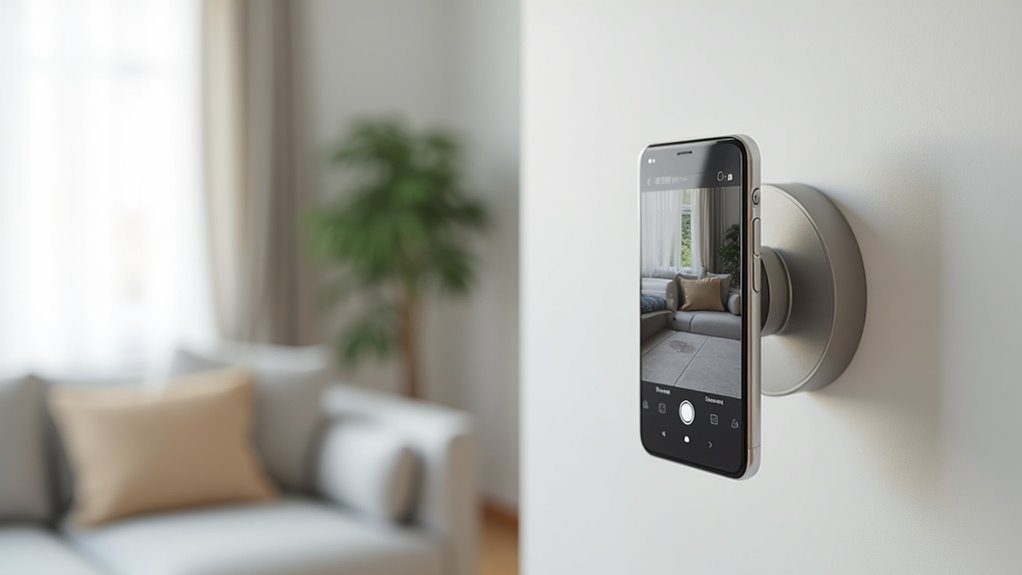
With your old smartphone properly prepared, you’ll need the right app to access its security camera potential. Instead of letting that old phone collecting dust gather more dust, these security camera apps can transform it into a powerful monitoring tool.
Alfred leads the pack with over 70 million downloads, offering live feed streaming, motion detection, and two-way audio capabilities. It’s a free app to turn your device into a thorough surveillance system.
Alfred transforms your old smartphone into a complete surveillance system with live streaming, motion detection, and two-way audio—all completely free.
AirDroid Personal provides real-time streaming for Android users, while SeeCiTV offers HD recording with low power consumption.
WardenCam delivers 24/7 surveillance with night vision and free cloud storage. Manything supports both iOS and Android platforms, making repurposing old smartphones incredibly versatile for security monitoring.
Step-by-Step Setup Process for Smartphone Security Cameras
You’ll need to start by downloading a security camera app like AlfredCamera on both your old smartphone and your monitoring device.
Next, you’ll pair these devices together by scanning a QR code to establish the connection between your camera and viewer.
Finally, you’ll mount your camera phone in the ideal location and test the live feed to verify everything’s working properly.
Download Security Camera App
Setting up your old smartphone as a security camera starts with downloading the right app, and Alfred stands out as one of the most reliable free options available.
You’ll need to download this security camera app on both your old smartphone (which becomes the camera) and your current device (the viewer). Head to the App Store or Google Play and install Alfred on both devices.
Make sure you sign in with the same Google account on each device to enable proper synchronization. The app transforms your old smartphone into a fully functional security camera with motion detection capabilities, adjustable video quality settings, and seamless streaming over your Wi-Fi connection, making it an excellent cost-effective surveillance solution.
Pair Camera and Viewer
After installing Alfred on both devices, the pairing process connects your old smartphone camera with your viewing device through a simple QR code scan.
On your Viewer device, tap ‘Add a Camera’ and select the appropriate camera type. Your old smartphone will display a QR code that you’ll scan with your current device to establish the connection.
Ensure both devices maintain a stable Wi-Fi connection for best streaming performance.
Once paired, you can access the live feed from your security camera through the Viewer app. Configure motion detection settings and notification preferences on the Camera device to customize your monitoring experience.
Test the connection by checking the live feed quality, then position your old smartphone in the ideal location for maximum coverage of your desired monitoring area.
Mount and Test Setup
Three essential considerations determine your camera’s effectiveness: placement, mounting, and power supply.
Position your smartphone strategically at entry points or near valuable items, ensuring the camera has an unobstructed view of critical areas. Use a small tripod or suction-cup mount to secure your phone, testing various angles before permanent placement to enhance the field of view.
Connect your smartphone to continuous power using a long charging cable, avoiding heat sources that could damage the device.
Once mounted, test your setup by checking the live feed on your viewer device. Adjust the camera angle as needed for ideal coverage.
Regularly monitor your camera’s functionality and placement, making real-time adjustments to maintain peak performance and thorough security coverage.
Optimal Placement Strategies for Maximum Coverage
Strategic camera placement transforms your repurposed smartphones into an extensive security network that maximizes coverage while minimizing blind spots.
You’ll achieve ideal visibility by positioning cameras near entry points like doors and windows where intruders typically attempt access. Mount devices in high corners to capture broader angles and monitor multiple areas simultaneously.
Consider these essential placement strategies:
- Position cameras within Wi-Fi range – Keep smartphones close to your router to maintain stable connections and prevent streaming disruptions.
- Use wide-angle positioning – Mount phones to capture expansive views, reducing the total number of cameras needed for thorough coverage.
- Test viewpoints before finalizing – Verify that critical areas remain visible and adjust angles to eliminate potential blind spots in your security network.
Power Solutions and Mounting Options
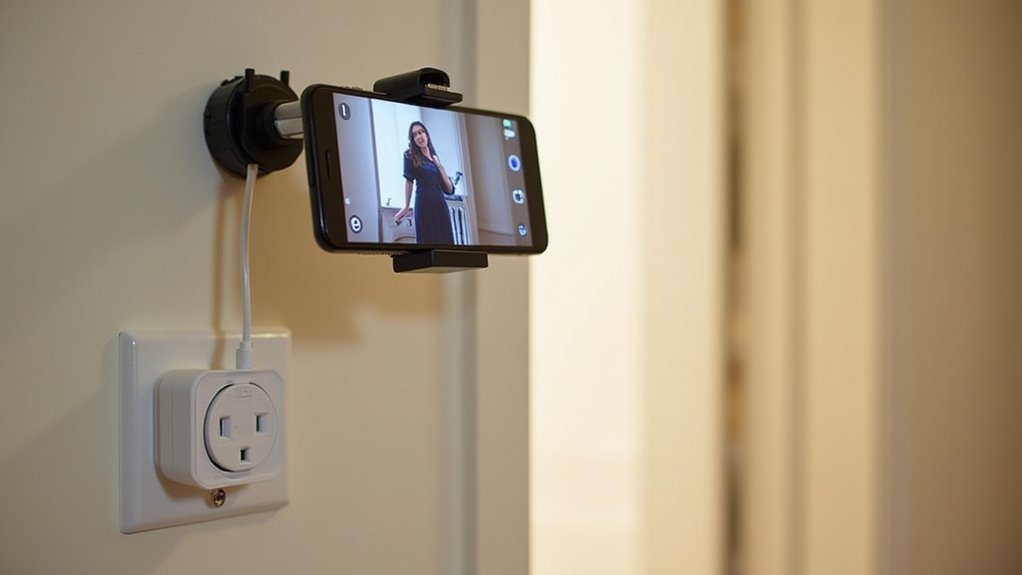
You’ll need to address continuous power requirements since your smartphone’s battery won’t last long during 24/7 monitoring.
Strategic mounting positions become essential when you’re working around power outlet locations and cable lengths.
Proper cable management solutions will keep your setup clean while ensuring your repurposed security camera stays powered and properly positioned.
Continuous Power Requirements
One critical factor that’ll determine your smartphone security camera’s success is maintaining continuous power throughout its operation.
Your old smartphone’s reliability depends entirely on consistent energy supply, as battery drain will render your camera useless when you need it most.
Position your device strategically near electrical outlets to guarantee uninterrupted monitoring. Use long Micro-USB, Lightning, or USB-C cables that provide flexibility while preserving secure connections.
Here’s how to enhance your setup:
- Secure cable management – Use tripods or suction-cup mounts that accommodate your power cable without causing disconnection
- Avoid heat sources – Keep cameras away from furnace vents to prevent overheating damage
- Monitor charging status – Regularly verify connections and power levels to maintain peak camera functionality
Consistent power monitoring guarantees your security system operates without interruption.
Strategic Mounting Positions
Where should you position your smartphone camera to maximize security coverage while maintaining reliable power access?
Strategic mounting positions require careful consideration of both visibility and security. Place your device near entry points, backyards, or areas containing valuables to guarantee a clear view of critical monitoring zones.
Mount cameras at heights that capture faces and movement while you minimize tampering risks. Corner placement works exceptionally well, maximizing visibility while reducing blind spots throughout your monitoring area.
Proper camera positioning involves using small tripods or suction-cup mounts for stability and flexibility. These tools allow you to achieve ideal angles without obstructing the field of view.
Remember to regularly test and adjust your camera’s position during setup, guaranteeing it effectively covers your intended monitoring zones while maintaining access to continuous power sources.
Cable Management Solutions
Once you’ve identified the perfect mounting location, maintaining continuous power becomes your next priority. Effective cable management guarantees your smartphone camera operates reliably without creating safety hazards or visual clutter.
To achieve ideal power solutions for continuous monitoring:
- Choose appropriate charging cables – Use long Micro-USB, Lightning, or USB-C cables that provide flexibility when you position the camera while maintaining a stable connection to your power outlet.
- Implement proper cable organization – Install adhesive cable clips or cable sleeves along walls and furniture to secure charging cables, preventing accidental disconnections and reducing tripping risks.
- Route cables strategically – Keep cables away from heat sources and high-traffic areas to prevent damage and guarantee your smartphone security system operates without interruption.
Preparing Your Old Phone for Security Duty
Before transforming your old smartphone into a reliable security camera, you’ll need to complete several essential preparation steps.
Start by performing a factory reset to wipe all personal data, protecting your privacy and security. Remove the SIM card and disable network connections to minimize vulnerabilities, especially since older devices won’t receive security updates.
Ensure your old smartphone is fully charged and functioning properly before proceeding. Download a security camera app like Alfred, which offers live streaming capabilities and motion detection features to enhance your device’s surveillance functionality.
Conduct a thorough performance check to verify everything works smoothly. Set a future disposal date for planning purposes, and remember to monitor the phone’s ongoing functionality throughout its security duties.
Understanding Security Risks and Data Protection
While preparing your old phone sets the foundation for security duty, you must understand the significant risks that come with repurposing aging devices. Aging smartphones typically stop receiving security updates after five to seven years, making them vulnerable to cyberattacks when connected online.
To minimize security risks and guarantee proper data protection, follow these essential steps:
- Complete data erasure – Wipe all personal data thoroughly and reset to factory defaults before repurposing your device.
- Network isolation – Disable unnecessary network connections to prevent unauthorized access to your system.
- Privacy-focused apps – Choose security camera applications with robust privacy features like App Lock and Trust Circle.
Regular performance evaluations and setting a definitive use-by date help you manage ongoing security risks effectively while maintaining peak data protection.
Motion Detection and Alert Configuration
After setting up your repurposed smartphone as a security camera, you’ll need to configure motion detection settings to maximize its effectiveness.
Security camera apps like Alfred and Manything provide customizable settings that let you adjust the sensitivity level to prevent false alerts from minor movements. You can define specific detection zones within your camera’s view, focusing on critical areas while ignoring less important spaces.
Smart motion detection apps allow you to customize sensitivity settings and create specific detection zones to minimize false alerts while monitoring key areas.
Configure instant alerts to receive notifications when significant movement occurs, ensuring you’re immediately aware of potential security issues.
Enable cloud recording features to automatically save video footage triggered by motion events. This creates a valuable record you can review later.
Remember to regularly update your app, as developers frequently release improvements that enhance motion detection performance and overall functionality.
Remote Monitoring and Live Streaming Features
Once your smartphone security camera is actively detecting motion, you’ll want to take advantage of remote monitoring capabilities that let you watch live feeds from anywhere.
Security camera apps like AlfredCamera and WardenCam provide thorough remote monitoring through real-time feeds accessible via cellular or Wi-Fi networks.
Key live streaming features include:
- Real-time video and audio streaming – Watch live feeds while hearing sounds from monitored areas simultaneously.
- Multi-network connectivity – Stream over both cellular and Wi-Fi to maintain constant access from virtually any location.
- Cloud storage integration – Automatically save recorded footage for later review of security events.
These remote monitoring capabilities guarantee you’ll stay connected to your property’s security, providing peace of mind whether you’re at work or traveling.
Managing Multiple Camera Devices
You can transform multiple old smartphones into an extensive security network by adding unlimited cameras through the Alfred app.
Once you’ve set up several devices, you’ll need to organize your camera feeds strategically to monitor different areas like entrances, backyards, and rooms with valuables.
The app lets you switch between camera feeds seamlessly, giving you complete control over your multi-device security system from a single viewer.
Adding Multiple Cameras
When setting up extensive home surveillance, the Alfred app’s ability to support unlimited camera devices transforms your collection of old smartphones into a powerful security network.
You’ll maximize your monitoring capabilities by strategically positioning multiple cameras throughout your property.
The Alfred app streamlines managing several devices simultaneously:
- Position cameras at key locations – Place old smartphones at entry points, backyards, and rooms containing valuables for thorough coverage.
- Enable live streaming and motion detection – Configure all connected devices to provide real-time alerts and continuous monitoring from your primary viewer.
- Set up Trust Circle access – Grant trusted family members or friends simultaneous viewing permissions across all multiple cameras in your network.
Regular optimization of each device’s motion sensitivity and notification settings guarantees your expanded surveillance system operates effectively.
Organizing Camera Feeds
Managing multiple smartphone cameras becomes effortless when you establish a logical naming system within your security app. When organizing camera feeds, assign specific names to each device that clearly identify their locations and purposes, such as “Front Door,” “Backyard,” or “Living Room.”
Alfred makes this process straightforward through intuitive camera options that allow you to customize each feed’s identity.
Create a Trust Circle within your monitoring app to enable trusted family members or colleagues to access and manage different camera feeds collaboratively. This feature guarantees extensive coverage while distributing monitoring responsibilities effectively.
Configure notifications individually for each camera to receive relevant alerts without overwhelming yourself. Focus on motion detection for high-priority areas while adjusting camera settings like sensitivity levels based on each device’s specific location and monitoring requirements for peak performance.
Maintenance and Software Updates
Once you’ve transformed your old smartphone into a security camera, maintaining its software becomes essential for peak performance and protection.
Regular maintenance prevents vulnerabilities from compromising your security system while ensuring superior functionality.
Here’s your maintenance checklist:
- Enable automatic app updates – Configure your security camera app to update automatically, ensuring you receive the latest security enhancements and features without manual intervention.
- Monitor performance indicators – Watch for lag, connectivity issues, or crashes that signal needed software updates or potential hardware limitations affecting your camera’s reliability.
- Plan for retirement – Set a replacement timeline of five to seven years post-release, then pursue responsible recycling when security updates cease and vulnerabilities increase beyond acceptable levels.
Regular maintenance protects your investment while maximizing your repurposed smartphone’s security capabilities.
Best Use Cases for Smartphone Security Cameras
You’ll find smartphone security cameras excel in specific scenarios where traditional systems aren’t practical or cost-effective.
They’re perfect for monitoring your home’s entry points, tracking package deliveries, and keeping watch over pets, babies, or elderly family members throughout your house.
You can also deploy them as temporary security solutions when traveling, staying in hotels, or moving to new locations where permanent camera installation isn’t feasible.
Home Monitoring Applications
While professional security systems can cost thousands of dollars, repurposing your old smartphones creates an effective monitoring network that addresses real security concerns in your home.
With package theft affecting one in six US adults, strategic placement of these devices transforms them into powerful security cameras for thorough home monitoring.
Applications like Alfred and AirDroid Personal enable live streaming, motion detection, and remote access capabilities that rival expensive systems.
You’ll gain real-time surveillance of entry points and vulnerable areas where packages typically get stolen.
Key home monitoring applications include:
- Package theft prevention – Monitor doorsteps and delivery areas during peak shipping times
- Pet monitoring – Check on your furry companions while you’re away from home
- Vacation security – Deploy temporary monitoring solutions in hotels or unoccupied properties
Temporary Security Solutions
Whether you’re traveling to unfamiliar locations or need quick surveillance during life changes, smartphone security cameras excel as temporary monitoring solutions that deploy within minutes.
You can transform old smartphones into effective security cameras for hotel rooms, rental properties, or temporary living situations where you need immediate peace of mind.
These budget-friendly temporary solutions prove invaluable during peak delivery seasons when package thefts increase dramatically. You’ll monitor doorsteps and entry points without purchasing expensive equipment.
Life changes like moving, home renovations, or extended business trips become less stressful when you can quickly establish surveillance coverage.
Your repurposed devices offer flexibility that traditional systems can’t match, allowing you to relocate cameras instantly as security needs adapt throughout different situations.
Planning Your Phone’s End-of-Life Disposal
Even though your old smartphone has found new purpose as a security camera, you’ll eventually need to plan for its final disposal.
After five to seven years post-release, your device becomes less secure and functional, making retirement necessary.
When that time comes, follow these essential steps:
- Wipe all personal data and reset your old smartphone to factory settings to protect your privacy from potential data breaches.
- Research local recycling programs for electronics in your area, as these handle hazardous materials like lithium batteries safely while minimizing environmental impact.
- Consider donation opportunities to organizations accepting used devices, giving your phone another chance to help someone in need rather than ending up in landfills.
Proper disposal protects both your personal information and the environment.
Frequently Asked Questions
Can I Turn My Old Phone Into a Security Camera?
You can absolutely turn your old phone into a security camera. Download apps like Alfred, wipe personal data first, then position it strategically to monitor entry points with live streaming and motion detection features.
What Is the Best Free App to Use Old Phone as Security Camera?
You’ll want Alfred as your best free option, offering motion detection and live streaming with over 70 million downloads. WardenCam’s another solid choice with free cloud storage and night vision capabilities.
Can I Use an Old Phone as a Camera Without a SIM Card?
You can definitely use an old phone as a camera without a SIM card. It’ll connect through Wi-Fi instead of cellular networks, which actually makes it more secure while still allowing remote monitoring capabilities.
Is the Alfred Camera App Free?
Yes, you can download and use Alfred Camera app for free. You’ll get basic features like live streaming and motion detection, but you’ll need Alfred Premium starting at $2.49/month for advanced features.


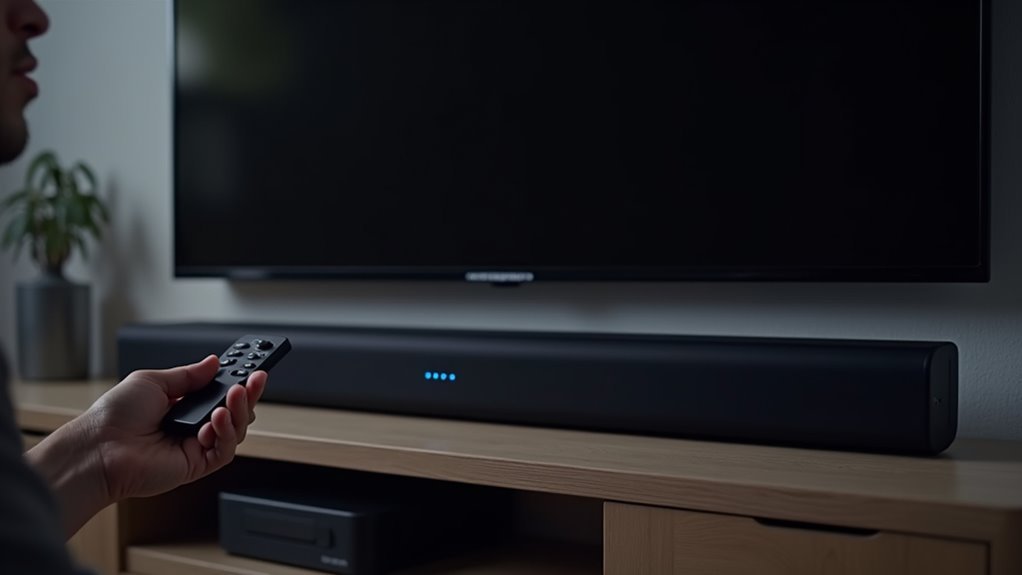
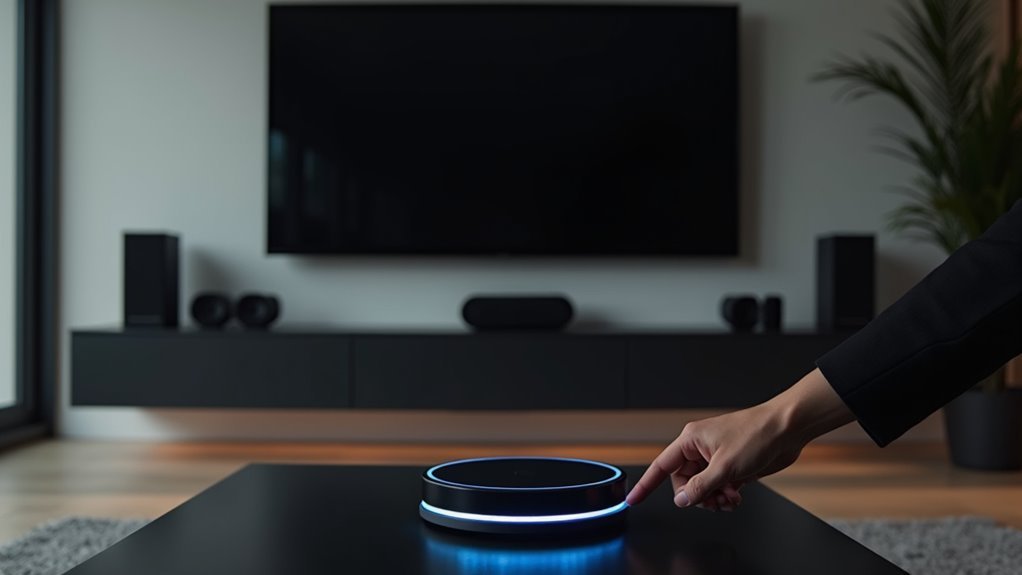
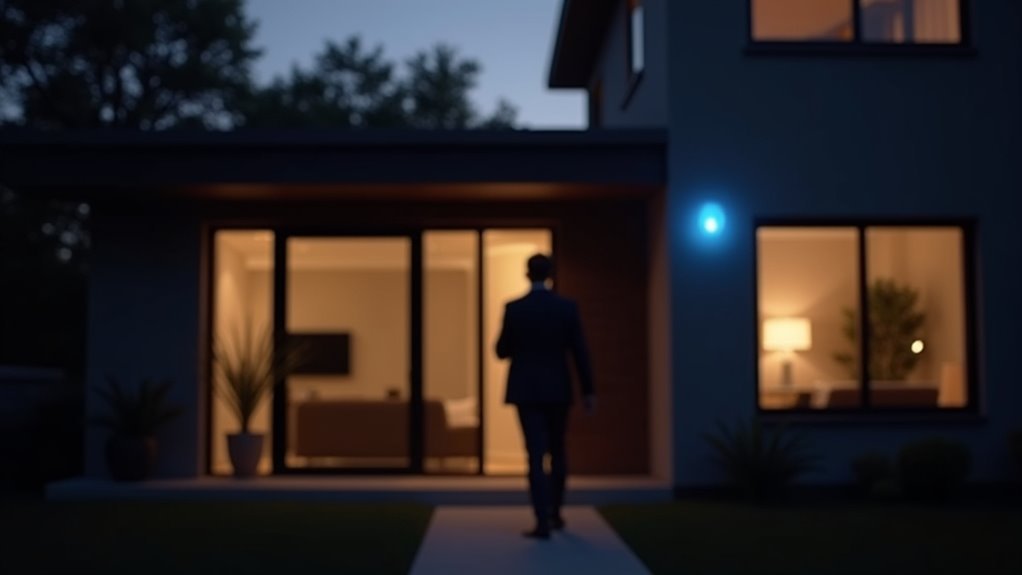
Leave a Reply